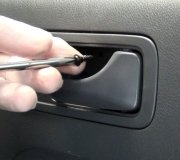First of all, watch the tachometer to see if engine speed increases 200 rpm when this happens. If it does, the torque converter is unlocking. It should re-lock about three or four seconds later. It does this for one of two reasons. Tapping the brake pedal is the signal telling the engine computer you are planning on slowing to a stop. It unlocks the torque converter to let the engine keep running in gear, similar to pushing the clutch pedal for a manual transmission. If the brake light switch is out-of-adjustment, slight movement of the brake pedal can turn the switch on momentarily, mimicking tapping the brake pedal. To identify this, just hold the brake pedal up with your toes to prevent it from pushing the switch.
The torque converter also unlocks when the accelerator pedal nears wide-open-throttle. That returns the drive train to twice the torque it would have with a manual transmission, for passing or going up a steep hill. The lock-up feature for better fuel mileage, (a Chrysler invention), eliminates the torque converter's torque doubling during cruising, which is okay because it is not needed then.
When the torque converter unlocks during periods of increased acceleration, it is also accompanied by increased engine speed, and possibly down-shifting and a bigger engine speed increase. To the cruise control system, that can look like you bumped the shift lever into neutral. Most cruise systems are designed to disengage when it sees that to prevent damaging the engine.
Along with engine speed, the computer also watches throttle position, or more specifically, rate of throttle position change. Normal operation is for the signal voltage reading from the throttle position sensor to change gradually as you push the pedal or the cruise pulls on its cable. An intermittent contact inside the throttle position sensor will cause the signal voltage seen by the computer to go to 5.0 volts which is an unacceptable condition. If that bad connection is brief enough, it is possible no diagnostic fault code will be set, but that still will cause the torque converter to unlock, then re-lock. That glitch is enough to cause the cruise control to turn off. Chrysler's throttle position sensors cause extremely little trouble, except on the diesel engines. The failure rate is not huge, but those that do cause trouble are almost always on the diesel engines.
The place to start the diagnosis is with reading and recording the diagnostic fault codes. If there are none related to the cruise control, the next step is for your mechanic to test-drive the truck with a scanner connected. I have a Chrysler DRB3 for all of my vehicles. Among other data, it shows the "reason for last cutout" for the cruise control. You need to view this when the problem occurs while driving. If you try to read it in the shop or parking lot, the reason will be, "vehicle speed too low", or "ignition switch was turned off". Once you are driving down the road, neither of those conditions will occur. If you see "brake pedal pushed" pop up, you will know where to look. If you see, "ignition switch turned off", obviously it was not, but that would point you to an intermittent connection in a wiring harness. The engine computer can also detect an intermittent connection between a pair of terminals in the servo's connector, and intermittent connections in the cruise control switches.
Sunday, December 3rd, 2017 AT 5:36 PM


